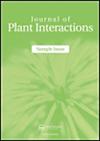寄生虫与人体壁面相互作用的分子机制。和向日葵
IF 3.3
3区 生物学
Q2 PLANT SCIENCES
引用次数: 1
摘要
【摘要】山核桃。是威胁中国向日葵生产最严重的寄生杂草,它侵染向日葵根部,造成严重的产量和经济损失。本研究确定了O. cumana侵染对向日葵生长、生理生化、光合等指标的影响,并利用RNA-Seq分析了寄生互作的潜在调控因子。结果表明,侵染对向日葵株高、鲜重、叶绿素含量、光合作用及MDA含量均有显著抑制,SOD和POD活性均有不同程度提高,这可能与向日葵抗侵染有关。此外,还筛选出6个与寄生虫相关的基因,这些基因在植物激素信号转导、光呼吸和苯丙素代谢途径中显著富集。其中,HsP90A、MYC2和HAO基因为首次在向日葵与古麻寄生互作中发现。研究结果为揭示古麻与向日葵寄生相互作用的分子机制奠定了基础。本文章由计算机程序翻译,如有差异,请以英文原文为准。
Molecular mechanism of the parasitic interaction between Orobanche cumana wallr. and sunflowers
ABSTRACT Orobanche cumana Wallr. is the most serious parasitic weed that threatens sunflower production in China, it infects sunflower roots and causes severe yield and economic losses. This study determined the effects of O. cumana infection on sunflower growth, physiological, biochemical, photosynthesis indexes and used RNA-Seq to investigate the potential regulatory factors involved in the parasitic interaction. Results showed that O. cumana infestation significantly inhibited sunflower height, fresh weight, chlorophyl contents, photosynthetic and the MDA content, SOD and POD activities were increased in different degrees, which might be related to sunflower resistance to O. cumana infestation. Additionally, six parasite-related genes were selected, which markedly enriched in plant hormone signal transduction, photorespiration and phenylpropanoid metabolism pathway. Among these genes, HsP90A, MYC2 and HAO were discovered for the first time in sunflowers and O. cumana parasitic interaction. Undoubtedly, the results lay a foundation for revealing the parasitic interactions molecular mechanism of O. cumana and sunflowers.
求助全文
通过发布文献求助,成功后即可免费获取论文全文。
去求助
来源期刊

Journal of Plant Interactions
PLANT SCIENCES-
CiteScore
5.30
自引率
6.20%
发文量
69
审稿时长
>12 weeks
期刊介绍:
Journal of Plant Interactions aims to represent a common platform for those scientists interested in publishing and reading research articles in the field of plant interactions and will cover most plant interactions with the surrounding environment.
 求助内容:
求助内容: 应助结果提醒方式:
应助结果提醒方式:


